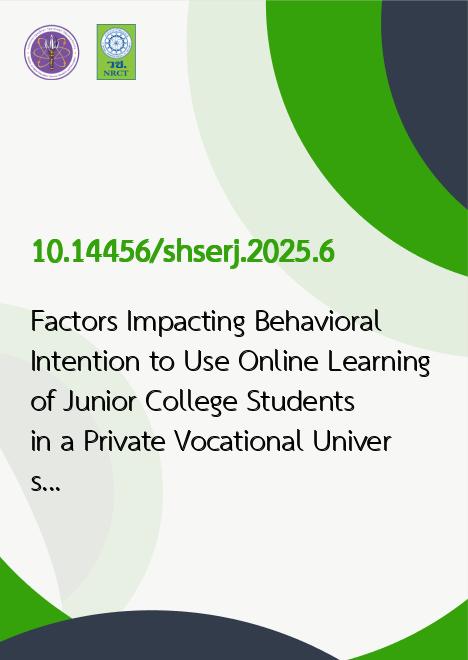
|
Factors Impacting Behavioral Intention to Use Online Learning of Junior College Students in a Private Vocational University in Chengdu, China |
|---|---|
| รหัสดีโอไอ | |
| Creator | Zhong Yangbaixue |
| Title | Factors Impacting Behavioral Intention to Use Online Learning of Junior College Students in a Private Vocational University in Chengdu, China |
| Publisher | Assumption University Press |
| Publication Year | 2568 |
| Journal Title | The Scholar: Human Sciences |
| Journal Vol. | 17 |
| Journal No. | 1 |
| Page no. | 53-65 |
| Keyword | E-Learning Quality, Perceived Usefulness, Perceived Ease of Use, Behavioral Intention |
| URL Website | http://www.assumptionjournal.au.edu/index.php/Scholar/article/view/7735 |
| Website title | The Scholar: Human Sciences |
| ISSN | 2586-9388 |
| Abstract | Purpose: This study aims to determine factors impacting behavioral intention of students painting majors in a private vocational university in Chengdu, China. The conceptual framework contains perceived ease of use, responsiveness, reliability, perceived usefulness, e-learning quality, hedonic motivation, facilitation condition, social influence, and behavioral intention. Research design, data, and methodology: Quantitative methods were employed to survey a cohort of 500 participants. Prior to data collection, the study ensured the validity and reliability through the assessment of the Item-Objective Congruence (IOC) index and the calculation of Cronbach's Alpha during a pilot test involving 50 participants. Confirmatory factor analysis (CFA) and Structural Equation Modeling (SEM) were to assess and conduct statistical data processing. Results: perceived usefulness emerges as the most influential factor affecting behavioral intention. Furthermore, it is observed that perceived ease of use significantly contributes to perceived usefulness. Additionally, the study affirms the substantial impacts of reliability and responsiveness on the quality of the e-learning experience. Lastly, hedonic motivation, facilitating conditions, social influences, and the perceived quality of e-learning all collectively affect students' behavioral intentions in the online learning environment. Conclusions: The author elaborates on the relevant factors that affect the online learning behavior intention and how to improve their behavior intention, e-learning quality, and perceived usefulness. |
